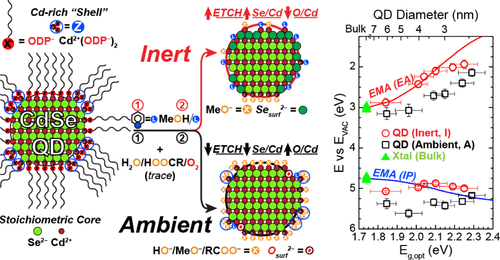当前位置:
X-MOL 学术
›
J. Phys. Chem. C
›
论文详情
Our official English website, www.x-mol.net, welcomes your
feedback! (Note: you will need to create a separate account there.)
Influence of the Processing Environment on the Surface Composition and Electronic Structure of Size-Quantized CdSe Quantum Dots
The Journal of Physical Chemistry C ( IF 3.3 ) Pub Date : 2020-09-04 , DOI: 10.1021/acs.jpcc.0c05622 R. Clayton Shallcross 1 , Amy L. Graham 1 , Metin Karayilan 1 , Nicholas G. Pavlopoulous 1 , Jordan Meise 1 , Jeffrey Pyun 1 , Neal R. Armstrong 1
The Journal of Physical Chemistry C ( IF 3.3 ) Pub Date : 2020-09-04 , DOI: 10.1021/acs.jpcc.0c05622 R. Clayton Shallcross 1 , Amy L. Graham 1 , Metin Karayilan 1 , Nicholas G. Pavlopoulous 1 , Jordan Meise 1 , Jeffrey Pyun 1 , Neal R. Armstrong 1
Affiliation

|
We show here how differences in surface composition for monolayer (ML)-tethered pyridine (Py)-treated CdSe quantum dots (QDs) affect band edge energetics, as a function of QD diameter. We compare UV–vis spectroscopy of QD solutions and X-ray (XPS) and ultraviolet (UPS) photoelectron spectroscopy of QDs tethered to 1,6-hexanedithiol-modified Au surfaces. Differences in QD surface composition are brought about by differences in solvent composition during displacement of the native, X-type octadecylphosphonate (ODP–) ligands with Py and by differences in exposure to trace H2O and O2 during QD processing. Prior to surface tethering, exchange of the ODP– ligands with Py ligands under ambient (A) conditions leads to some surface passivation of the QD and no appreciable reduction in the spectroscopically estimated QD diameter. QDs processed in completely inert (I) environments (O2 and H2O below detection limits in the solvents, processing environments, and during analysis) undergo a small decrease in diameter during Py exchange and an increase in size dispersity. These simple differences in processing conditions lead to important differences in QD band edge energetics which will impact their use as photocatalysts and photovoltaic or light-emitting diode active layers. XPS characterization of Py-capped QD-tethered MLs, compared with freshly etched CdSe(0001) single-crystal surfaces, indicates that I QDs show a higher Se surface coverage relative to A QDs. For A QDs, we propose that trace H2O present during processing provides a proton source that facilitates ODP– desorption and replacement with charge-compensating HO– ligands, which inhibits subsequent changes in QD surface composition. UPS-derived size-quantized ionization potentials (IPs) and electron affinities (EAs) for I QDs, corrected for shifts in the local vacuum level, closely track the energetic shifts predicted by the effective mass approximation (EMA). The vacuum level-corrected IP/EA values for A QDs show sizeable deviations from the EMA. We also describe an approach for characterization of UPS data for these QD MLs, which greatly enhances the sensitivity to mid-gap states above the VBM (seen for I QDs which are slightly enriched in surface Se) and offers a general approach to all semiconductor materials with low density of states in the valence band region. This study confirms the influence of ligand modification and processing environment on QD surface composition, which in turn impacts the CdSe QD energy levels that are important to applications in photocatalysis and optoelectronic device platforms.
中文翻译:

加工环境对尺寸量化的CdSe量子点表面成分和电子结构的影响
我们在这里显示了单层(ML)系吡啶(Py)处理的CdSe量子点(QDs)的表面组成差异如何影响带边能量,这是QD直径的函数。我们比较了QD溶液的紫外可见光谱和QD束缚在1,6-己二硫醇修饰的Au表面上的X射线(XPS)和紫外(UPS)光电子光谱。QD表面组成的差异是由天然X型十八烷基膦酸酯(ODP –)配体置换为Py期间溶剂组成的差异以及QD加工过程中痕量H 2 O和O 2的暴露差异引起的。在进行表面束缚之前,在环境条件下将ODP –配体与Py配体交换(A)条件会导致QD的某些表面钝化,并且光谱估计的QD直径没有明显减少。在完全惰性(I)环境(在溶剂,处理环境以及分析过程中O 2和H 2 O低于检测极限)中处理的QD在Py交换过程中直径发生小幅减小,尺寸分散度增加。这些简单的加工条件差异导致QD谱带边缘能的重要差异,这将影响它们用作光催化剂和光伏或发光二极管活性层的用途。与新刻蚀的CdSe(0001)单晶表面相比,Py封盖的QD系链ML的XPS表征表明,I量子点显示硒相对较高的表面覆盖一个量子点。对于甲量子点,我们建议,跟踪ħ 2处理期间ö本提供一种便于ODP质子源-解吸和替换电荷补偿HO -配体,其抑制QD表面组合物的后续变化。由UPS衍生的I QD的尺寸量化电离势(IPs)和电子亲和力(EA)(已针对局部真空水平的变化进行了校正)密切跟踪了通过有效质量近似(EMA)预测的能量变化。真空度校正的A的IP / EA值QD显示与EMA有相当大的偏差。我们还描述了表征这些QD ML的UPS数据的方法,该方法极大地增强了对高于VBM的中间能隙状态的敏感性(适用于表面Q含量稍高的I QD),并为所有半导体材料提供了通用方法在价带区域具有低的状态密度。这项研究证实了配体修饰和加工环境对QD表面组成的影响,进而影响了CdSe QD能量水平,这对于光催化和光电器件平台中的应用至关重要。
更新日期:2020-10-02
中文翻译:

加工环境对尺寸量化的CdSe量子点表面成分和电子结构的影响
我们在这里显示了单层(ML)系吡啶(Py)处理的CdSe量子点(QDs)的表面组成差异如何影响带边能量,这是QD直径的函数。我们比较了QD溶液的紫外可见光谱和QD束缚在1,6-己二硫醇修饰的Au表面上的X射线(XPS)和紫外(UPS)光电子光谱。QD表面组成的差异是由天然X型十八烷基膦酸酯(ODP –)配体置换为Py期间溶剂组成的差异以及QD加工过程中痕量H 2 O和O 2的暴露差异引起的。在进行表面束缚之前,在环境条件下将ODP –配体与Py配体交换(A)条件会导致QD的某些表面钝化,并且光谱估计的QD直径没有明显减少。在完全惰性(I)环境(在溶剂,处理环境以及分析过程中O 2和H 2 O低于检测极限)中处理的QD在Py交换过程中直径发生小幅减小,尺寸分散度增加。这些简单的加工条件差异导致QD谱带边缘能的重要差异,这将影响它们用作光催化剂和光伏或发光二极管活性层的用途。与新刻蚀的CdSe(0001)单晶表面相比,Py封盖的QD系链ML的XPS表征表明,I量子点显示硒相对较高的表面覆盖一个量子点。对于甲量子点,我们建议,跟踪ħ 2处理期间ö本提供一种便于ODP质子源-解吸和替换电荷补偿HO -配体,其抑制QD表面组合物的后续变化。由UPS衍生的I QD的尺寸量化电离势(IPs)和电子亲和力(EA)(已针对局部真空水平的变化进行了校正)密切跟踪了通过有效质量近似(EMA)预测的能量变化。真空度校正的A的IP / EA值QD显示与EMA有相当大的偏差。我们还描述了表征这些QD ML的UPS数据的方法,该方法极大地增强了对高于VBM的中间能隙状态的敏感性(适用于表面Q含量稍高的I QD),并为所有半导体材料提供了通用方法在价带区域具有低的状态密度。这项研究证实了配体修饰和加工环境对QD表面组成的影响,进而影响了CdSe QD能量水平,这对于光催化和光电器件平台中的应用至关重要。











































 京公网安备 11010802027423号
京公网安备 11010802027423号